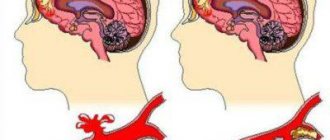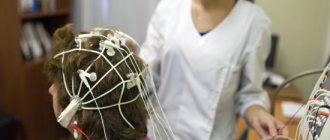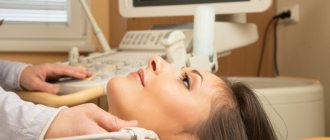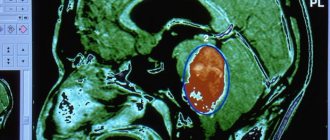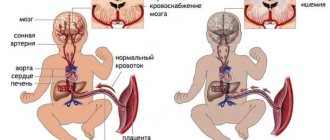Micropolarization of the brain and spinal cord (TCMP and MPSM) is a new highly effective therapeutic method that allows you to specifically change the functional state of various parts of the central nervous system (RF Patent No. 2122443 dated 07/01/97). TCMP (TRANSCRANIAL MICROPOLARIZATION) and MPSM (SPINAL CORD MICROPOLARIZATION) successfully combine the simplicity and non-invasiveness of traditional physiotherapeutic procedures (electrosleep, various types of galvanization) with a fairly high degree of selectivity of effects characteristic of stimulation through intracerebral electrodes. The term “micropolarization” characterizes direct current parameters at the levels of physiological values used for TCMP and MPSM procedures (as a rule, they are an order of magnitude smaller than those traditionally used in physiotherapy and do not exceed 1 mA for TCMP, 5 mA for MPSM). The direction of influence is achieved through the use of small areas of electrodes (100-600 sq.mm.), located on the corresponding cortical (frontal, motor, temporal and other areas) or segmental (lumbar, thoracic and other levels) projections of the brain or spinal cord .
The choice of impact zones is determined by the nature of the pathology, treatment objectives, functional and neuroanatomical features of the cortical fields or parts of the spinal cord, their connections, as well as the nature of the functional asymmetry of the brain and spinal cord.
TCMP allows for a targeted effect not only on cortical structures located in the subelectrode space, but also through a system of corticofugal and transsynaptic connections to influence the state of deeply located structures.
MPSM makes it possible to specifically influence not only various parts of the spinal cord located in the subelectrode space, but also, through conduction systems, to influence the state of underlying and overlying structural formations, up to the structures of the brain.
Indications for TCMP and MPSM: Diseases of the central nervous system, consequences of infectious and traumatic lesions of the brain and spinal cord, episyndrome, amblyopia, nystagmus, neuroses, mental retardation, delayed mental and speech development, and many others.
During therapeutic sessions of micropolarization, normalization of muscle tone is noted, a decrease in the severity of pathological postnotonic reflexes, hyperkinesis, an increase in the range of movements, a decrease in the severity of vicious postures (crossing of the legs, flexion of the feet, flexion of the arms), support appears or improves, new motor skills are acquired (crawling, sitting, standing, walking, manual skill), etc. In addition, there is a decrease in aggressiveness, fear, improved mood, increased motivation for further treatment, increased interest in the environment, improved learning ability, increased contact, and normalized sleep. Speech itself becomes more meaningful and clear, understanding of spoken speech improves or appears, and the appearance of new sounds and words is noted.
Contraindications for TCMP and MPSM: Obvious contraindications to the use of the method include pronounced EEG signs (in combination with clinical examination data) of intracranial hypertension; suspected brain tumors; diffuse headache (GB), intensely increasing day by day; a pronounced dependence of headache intensity on the position of the head and body; combination of headache with repeated vomiting without nausea; persistent unilateral headache; morning headaches; an increase in headache parallel to an increase in temperature; a rise in blood pressure above 200/120 mmHg accompanying headache; months-long headaches with no remission that cannot be treated; meningeal signs; change in paraclinical data.
Transcranial micropolarization of the brain (TCMP, tDCS - transcranial Direct Current Stimulation) is a non-invasive and painless method of influencing brain cells (neurons) and treating brain dysfunctions. This method was proposed and developed in the laboratory of N.P. Bekhtereva at the Institute of Experimental Medicine (St. Petersburg).
Brain micropolarization uses direct, very low-intensity electrical currents to stimulate specific areas of the brain. A direct current (no more than 1 milliampere) passes through two electrodes located on the scalp and thus modulates the activity of neurons. This current strength can be comparable to the brain’s own electrical currents and therefore does not cause harm to health. In essence, this is a soft physiotherapeutic effect (in the handbook on physiotherapy for doctors G.N. Ponomarenko (1999) it is described as “central anodization” or galvanization of the brain).
When exposed to specific brain structures, this small current promotes the formation of new connections between brain cells, thus stimulating and improving interneuronal and interstructural interactions, which leads to increased functionality of the human brain.
What is important is the almost complete absence of side effects after the procedures (slight itching on the skin in the area of treatment is possible).
Currently, the TCMP technique is actively being developed, studied and used in various clinics in Russia and abroad.
Micropolarization of the brain for children and adults: indications and contraindications
At the moment, the micropolarization method is not widely available due to the difficulty of averaging results due to the use of instruments from different manufacturers and the insufficient number of control studies.
However, this method has proven itself well in the treatment of speech therapy and behavioral defects. What diseases can be treated with TCM of the brain?
Due to the fact that the method has been shown to be quite effective, it can be used both independently and as part of complex treatment in adults and children.
Research shows that TCMP may be a valuable tool in the treatment of:
- Neuropsychiatric diseases such as depression, anxiety, fears, Parkinson's disease, chronic pain, tics
- Cerebral palsy of varying severity
- Organic lesions of the central nervous system
- Vascular diseases of the brain
- Traumatic brain injuries
- After neuroinfectious diseases of the brain
- Neuroses
- Hearing impairment ( sensorineural hearing loss)
- Visual impairment (nystagmus, strabismus)
- Speech development disorders in children
- Developmental delay
- Hyperactivity disorder, attention deficit disorder
- Epileptic syndrome
It has been shown that as a result of the use of brain micropolarization, recovery processes after a stroke are enhanced by 3 times, visual acuity is increased by 2 times, and speech functions are improved by 2-3 times. Moreover, in children the effectiveness of the TCMP technique is several times greater than in adults. Studies have shown that after the use of micropolarization of the brain in children with mental retardation, significant changes in socialization and correction of the condition are noted.
In children with attention deficit hyperactivity disorder, TCMP of the brain helps improve cognitive functions of the brain, memory, emotional status of the child, attention, normalizes sleep, and reduces impulsivity.
In case of speech disorders, significant positive changes are observed when influencing the speech areas, and the effect exceeds the result of drug therapy.
Micropolarization can also be used in healthy people to improve brain function during stress (exams, stress, intense intellectual work).
Due to the fact that, unlike other techniques (electroconvulsive therapy, magnetic stimulation, transcranial electrical stimulation), which are contraindicated for epilepsy, a weak micropolarization current can be used to activate the brain’s own anti-epileptic system.
It is important to note that with Down syndrome, early childhood autism and other genetic diseases that affect mental and speech development, micropolization is used with caution due to insufficient knowledge of the diseases. Typically, results are either negligible or non-existent. No deterioration of the condition was observed.
There are a number of contraindications to the use of brain micropolarization:
- Individual intolerance to electric current;
- Tumors;
- Colds and infectious diseases;
- Increased body temperature;
- Presence of foreign bodies in the skull (tissue substitute);
- Systemic blood diseases;
- Hypertonic disease;
- Severe cerebral atherosclerosis;
- Damage to the skin in the affected area.
The procedures are incompatible with nootropic therapy, acupuncture, MRI, vibration stimulation and electrical muscle stimulation, and the use of various strong psychotropic drugs.
This method can only be used by a qualified neurophysiologist in a medical institution after prior consultation with a therapist.
Impressions of this procedure from those who have undergone it
In numerous forums dedicated to brain diseases, this treatment method is actively understood and discussed. What are the impressions of parents about such a procedure as micropolarization of the children’s brain? Reviews on specialized forums are varied - some liked the procedure, and the effect was well expressed (according to one of the mothers of a disabled child, her son became calmer, the first signs of speech and consciousness began to appear, the number of involuntary inappropriate actions decreased).
Others describe the procedure as useless. They did not experience any positive effect from it, or it was minimal, and it could be attributed to success in activities with the child, self-healing, or simply regression of the process.
Note that those who have undergone micropolarization of the brain leave both positive and negative reviews. It is because of this that it is impossible to judge the effectiveness of the procedure, since the results are in the widest range.
The only proven positive effect of micropolarization can be considered an improvement in brain waves recorded on the EEG (electroencephalogram), although for many children with autism this indicator is not effective, since their brain activity is no different from normal.
How is the transcranial micropolarization procedure performed?
A cap with electrodes is put on the patient’s head, which are connected to a special device. Before performing TCMP, a mandatory EEG examination is necessary, since the location of the electrodes is determined precisely by the features of the EEG recording data. Recording an EEG allows you to assess the overall activity of the brain, identify pathological activity, and evaluate the characteristics of brain development.
Transcranial micropolarization of the brain (TCMP) is a type of therapy that is based on continuous exposure to certain brain structures through a low-intensity electric current. TCMP was developed by scientists from the Institute of Experimental Medicine in Leningrad. At the moment, this procedure is carried out in some medical institutions in different countries for therapeutic effects on patients of any age.
There are procedures such as transcranial and transvertebral micropolarization of the brain (TCMP and TVMP). TVMP is carried out relative to the spinal cord, while at the same time, TCMP involves the brain.
What it is?
The brain is a real computer that organizes and plans the work of all organs. The functioning of this organ is quite complex. This is due to the variety of different functions that it performs. The brain should be affected using the most gentle method possible. This can be achieved by using micropolarization.
This method has proven itself well in pediatric neurology. The therapeutic effect of various brain pathologies is carried out using direct electric current. It is quite small and does not exceed 1 mA in intensity. This effect is quite comparable to natural tension in brain cells (neurons). This makes it possible to safely use this method in the youngest patients.
Transcranial micropolarization is a unique method of treating the brain in children.
Several scientists in different countries of the world worked on the creation of this technique. It took more than a hundred years to develop this method. Our country can rightfully be proud that the first procedure for micropolarization of the brain was carried out at the Psychoneurological Institute. Bekhterev.
It should be noted that the method has not found widespread application.
This is due to several reasons: the occurrence in some cases of technical errors during the procedure, the wide range of values obtained, and the lack of clear and recognized standardization of results. According to statistics, micropolarization of the brain is performed more often in children than in adults. There are certain indications and contraindications for such treatment.
Indications
This method of therapy can be used for patients with pathologies of the nervous system, such as:
- hyperactivity;
- attention deficit hyperactivity disorder (ADHD);
- tics and neurosis-like pathologies;
- psychosomatic diseases;
- speech pathologies in pediatric patients;
- traumatic brain injuries and their complications
- epilepsy (therapy is not carried out in all centers, since there is debate about the appropriateness of such therapy for epilepsy);
- cerebral palsy (CP);
- psycho-emotional diseases;
- delayed psycho-neurological development in children;
- organic lesions of the central nervous system;
- depression, fears;
- enuresis;
- aggression;
- encopresis;
- diseases of the optic nerve;
- neuroinfections;
- sensorineural hearing loss;
- asthenic syndrome;
- headache;
- transformations of the brain due to age.
, , , , ,
Truth or myth?
Despite the increasing relevance of the method, its effectiveness is increasingly being questioned. The main corporation that controls the quality of drugs, food products and medical procedures, the FDA, has not yet whitelisted transcranial micropolarization of the brain. The US Army is known to use this method in pilot training.
Important! If the electrodes are incorrectly localized, the impact of impulses on the brain can be harmful to health.
Preparation
Transcranial micropolarization for a child is no different from a similar procedure for an adult.
Before the procedure, you should be examined by an appropriate specialist who will issue a referral. This could be a speech therapist, psychotherapist or psychiatrist, neurologist or physiotherapist.
First, an EEG (electroencephalography) should be performed to assess brain function and damage. This study is carried out repeatedly during a course of treatment for TCMP to monitor the effectiveness of therapy over time.
If there are possible indications, the doctor may refer the patient for the procedure.
, , ,
Results that can be achieved
Micropolarization has been very actively used in recent years around the world due to its effectiveness. Numerous foreign studies have now been conducted that have confirmed the effectiveness of TCM (for example, research from the University of Oxford).
The use of this technique significantly increases the effectiveness of any rehabilitation program, speech therapy, or psychological classes. It is recommended to attend classes in parallel with the TCMP procedures.
A positive effect is sometimes noted already during the procedures, but in most cases it becomes noticeable after 2–3 months. It is advisable to repeat this treatment no earlier than after 2–4 months, because there is a long lasting aftereffect.
Transcanalial micropolarization is successfully used to treat:
- stuttering;
- delayed speech development;
- convulsive syndrome;
- spinal cord injuries;
- vascular diseases of the brain;
- visual impairment;
- hearing loss;
- hyperactivity in children.
Technique for transcranial micropolarization of the brain
TCMP is performed using a device for transcranial micropolarization. Electrodes are connected to the device, which are fixed in the correct position by a special helmet. After fixing the electrodes, the specialist selects the necessary parameters and starts the device. After starting, it begins to influence the brain with a permanent flow of electric current, which does not exceed the strength of its own processes in the brain and is calculated in amounts up to 1 mA. This way there is no aggressive stimulation to the brain that occurs in other electrical treatments.
A TCM session lasts from half an hour to 50 minutes. The patient is allowed to go about his business during the procedure. These can be both personal matters (for example, reading a book) and additional procedures in complex therapy (for example, classes with a speech therapist or rehabilitation specialist).
This type of treatment is allowed with medicated sleep. It is also allowed to use the TCM method while on mechanical ventilation.
Transcranial micropolarization can be used as an adjuvant therapy for various pathologies in children and adult patients, and is also used as an independent therapeutic method. The procedure regimen is prescribed individually and depends on the disease itself, the affected area of the brain and other factors. However, in all cases, one procedure will not bring the expected result. You should undergo a course of treatment consisting of at least 10 sessions. Recommendations may be given regarding additional activities such as general body massage, speech therapy massage, sessions with a psychologist, physical therapy and classes with a speech therapist. To consolidate the effect, you should repeat the course after 5-6 months.
More about the procedure
How is micropolarization of the children's brain carried out? Reviews of this technique are quite rare, as it is not widespread.
The procedure is not particularly complicated. A special helmet-cap with electrodes located on it is put on the patient’s head. It is part of a specialized device "Reamed-Polaris", specially designed for this procedure. The micropolarization method provides local effects on certain areas of the brain, due to which electrodes can be attached where pulse stimulation is needed.
During the procedure itself, the patient can actively go about his business (communicate, read a book, play). There are no unpleasant problems.
Stimulation time is about half an hour. This is the duration of one session, however, in order for any effect to be visible, several procedures must be carried out. The result is noticeable if the number of sessions required by micropolarization of the children’s brain is completed. Reviews usually note that success in treatment was observed after 8-10 regular procedures.
For some, according to reviews, 5-6 sessions were enough to get the first results, but it all depends on the individual characteristics of the brain.
Contraindications for carrying out
Contraindications to TCMP are:
- brain tumors (malignant);
- diseases of the cardiovascular system in severe stages;
- not intact skin on the head;
- presence of foreign objects in the skull;
- acute illnesses or exacerbation of chronic diseases of various etiologies, when body temperature is higher than normal, as well as connective tissue diseases of a systemic nature;
- on the areas of the head where the electrodes are supposed to be attached, there are tumors, pigmentation, and rashes;
- individual increased sensitivity to electric current.
There are some conditions in which TCMP is not advisable due to its low effectiveness. However, sometimes specialists prescribe transcranial micropolarization, since it cannot cause harm to these groups of patients, but gives little chance of positive dynamics. Among these pathologies:
- severe psychiatric illnesses;
- mental retardation;
- autism;
- Down syndrome;
- other genetic diseases.
During the therapeutic course, it is additionally prohibited:
- take psychotropic medications, in particular nootropics (TCMP is a complete replacement for taking nootropic drugs);
- take a course of acupuncture;
- undergo a course of vibration stimulation;
- undergo a course of electromyostimulation.
It's all about the protocol
The child receives a micropolarization session while doing physical exercises
– You say that the method is safe, but sometimes you read that a child experiences behavioral regression after TCMP sessions. Many parents fear that the latent seizure activity of the brain, which is often present in autism, may develop into full-blown epilepsy under the influence of currents.
– Theoretically, regression is possible if the protocol is incorrectly selected. If in a patient one of the centers of the cerebral cortex is already working to suppress other centers, and we begin to stimulate it, then, in principle, an exacerbation is possible. But I haven’t encountered anything like this yet.
As for epilepsy, it is even treated with micropolarization, placing the cathode at the epileptic focus. We have not done this yet, but we repeatedly took electroencephalograms during sessions and did not observe epi-activity.
At our clinic, we attach great importance to safety. You know what's funny?
READ MORE: Angiospasm of cerebral vessels symptoms
Those who are suspicious of TCMP often tell us: “Are you experimenting on children?!” Try your methods on yourself first!”
They don't know that this is literally what we do! We test any equipment first on ourselves. For example, the other day my colleague decided to see what would happen if he applied maximum current to the cathode, pressed mechanically and completely dried the electrically conductive gel - and he received a slight burn to the scalp, but did not find any negative effect on his own brain.
We never begin treatment unless the child has undergone a thorough examination. If a mother brings a child to our clinic without an EEG, we do this study on site for free. When drawing up a protocol, we take into account all the characteristics and problems of the patient, and try to make the therapy as targeted as possible.
There is always something new in TCMP - new protocols, new equipment. The American-made device that we are starting to use now has 5 electrodes: 4 of one sign and 1 of another. This allows the current to be more accurately focused and increases the depth of penetration.
Another characteristic of the device is the Limited Total Energy system, which does not allow the maximum permissible current strength to be exceeded, as well as a “parabolic” increase in current strength, which ensures its uniform increase, without jumps.
I would also draw the attention of parents to this. The specialist sets the current strength on the device, but we cannot be sure what the resistance is, so the real strength of the current going to the brain is unknown to us.
In order for the resistance to be constant, water must constantly flow from under the sponge under the electrode. Our laboratory assistants regularly water the sponge with a saline solution using a water pistol, this ensures a constant current strength. Parents should know this and see if this is monitored in the center where they take their child for procedures.
Consequences after the procedure
The effects that TCMP has on the patient’s body are divided into:
- local (tissue) reduction of inflammation, size of affected areas and swelling due to a positive effect on the nutrition of brain tissue
- systemic electric current directed to the brain contributes to changes in the functional state of its neurons. In this way, the brain’s regulation of various functions is restored by improving the interaction of various brain structures and its nerve cells.
Patients experience positive changes as a result of completing the course:
- in case of focal diseases of the brain, due to strokes and traumatic brain injuries, the affected area is significantly reduced, functions impaired due to the development of pathology are restored faster
- with speech or mental developmental delays in children, with ADHD, sleep, general emotional state, memory functions improve, attention sharpens, impulsivity decreases, speech develops, the child becomes more diligent and learnable, and his level of social adaptation increases
- convulsions and hyperkinesis disappear
Transcranial micropolarization should be performed about twice a year to obtain the most positive result, or more often as prescribed by a doctor (if the patient’s condition does not improve). After the first procedure, the effect is often unnoticeable, although some patients notice changes after the first session. Often, positive dynamics begin to be observed approximately in the middle of the course, and peak severity at the end of treatment and within 1-2 months after.
There are also no special rules for care after therapy sessions. The procedure is painless and the patient does not require additional care.
Micropolarization of the brain is a type of therapeutic procedure, during which changes occur in the functioning of brain neurons and stabilization of functional connections between individual organ structures. The methodology underlying treatment sessions ensures their safety, painlessness and high efficiency, prevention of behavioral disorders and pathological conditions of the central nervous system in children.
The main obstacles to the spread of micropolarization are the complexity and ambiguity of assessing the results, and the lack of standards for the equipment used.
Micropolarization is a method that successfully combines safety and non-invasiveness with a selective effect on brain cells, which has traditionally been achieved only through surgery.
During the procedures, certain areas of the brain are exposed to direct current, very weak in magnitude (about 100 μA). In comparison, more aggressively stimulating electrotherapy methods use a current of 1 mA.
A weak current acts similarly to natural brain impulses, gently changing the level of functioning of neurons and restoring connections between individual brain structures.
Micropolarization can be used to activate nerve cells in the brain (transcranial or TCMP) or spinal cord (transvertebral or TVMP). In the second case, the current strength will be slightly greater.
TCMP has both local and systemic therapeutic effects. The first is relevant for focal brain injuries, the second for general disorders of the functioning of the nervous system.
The term “micropolarization” itself reflects the characteristics of the influence used (microcurrent) and the essence of the electrical process, which consists in the polarization of the membranes of brain cells.
The invention of this treatment method was the result of experiments conducted in the laboratory of N.P. Bekhtereva. Development was almost completed in the 70s of the last century at the Institute of Experimental Medicine in St. Petersburg. The first session was held at the Psychoneurotic Institute. Bekhterev. Now micropolarization is used in a number of institutions in Russia, the CIS, and also abroad.
Features of TCMP
TCM causes a lot of controversy and controversy. Electric shock treatment comes as a shock to many parents. Some believe that electrodes can literally “fry the brains” of a child, but this is not so, and the safety of the procedure has been fully confirmed.
To date, the technique has not found widespread use in the world. Until now, the procedure is undergoing various tests and studies, and a complete database of results is formed for each diagnosis.
As for the results of treatment of children, they are quite satisfactory:
- after therapy there is an improvement in memory and thinking;
- psychological and emotional disorders decrease or completely disappear, sleep normalizes;
- children become more sociable, active, depressive views on life change to positive emotions, and interest in the world around them appears;
- positive effect of treatment of various developmental delays - the child’s speech becomes meaningful and clear, motor activity improves (we recommend reading: how is speech delay diagnosed and treated in children 2-3 years old?).
The first results of treatment are observed much earlier than with other types of therapy.
Data for children with autism and Down syndrome are conflicting. Scientists have not yet been able to study and identify all the features and details of the functioning of the brain of such patients. In most cases, the effect of TCMP was minimal or absent. But the fact has been reliably confirmed that microcurrent did not worsen the condition of any of the patients.
Transcranial micropolarization (TCMP) is a modern method of treating mental and neurological disorders using low voltage current. Micropolarization also restores partially or completely lost functions of the cerebral cortex and stem structures.
- Stabilization of psychophysiological functions, normalization of mood and behavior. Increasing the brain's sensitivity to information. This is necessary for further psychotherapy.
- Correction and elimination of the leading clinical syndrome.
- Elimination and rehabilitation of violations. For example, the threshold for convulsive readiness is reduced. This reduces the likelihood of developing an epileptic seizure.
This is a non-invasive and painless procedure that does not require intervention in the body. The main task of micropolarization is to change the functional state of different parts of the central nervous system for therapeutic purposes. For this purpose, the influence of current up to 1 mA is used.
The systemic effect of transcranial micropolarization is determined by the effect of current on nerve cells of the brain. Experimental studies prove that a current of 1 mA excites neurons and increases synaptic activity (stimulates the functioning of neural connections). A current with such strength stimulates the protective and compensatory forces of the body and the nervous system, in particular. In small doses, current stimulates self-healing of nervous tissue, neuroplasticity and regulates the internal stability of the body.
Cellular action is based on changes in biochemical processes due to the influence of current. This causes a polarization effect, that is, it changes the charge around the membrane, causing the neuron and its synapse to become excited. In other words, the cell comes into a working state.
Micropolarization can be used as an independent method of physiotherapy, or in combination with drug treatment. The treatment is used not only for diseases of the nervous system: micropolarization is also used as a “doping” for cognitive properties. Thus, American researchers applied the method to the military and found that after a micropolarization session, fighter pilots had increased concentration, reaction speed and speed of computing abilities.
Advantages of the method:
- non-invasive;
- painlessness;
- ease of use of micropolarization equipment;
- no side effects;
- a large number of indications;
- relatively quick results: signs of improvement in the functioning of the nervous system appeared within a month;
- quick sessions: from 30 to 50 minutes - one procedure.
Visual indicators of the effectiveness of transcranial micropolarization are presented using the example of treatment of movement disorders:
- Motor functions improved in 79% of patients.
- In 90% of patients, the severity of pathological reflexes decreased, muscle tone normalized, and patients learned to control movements.
- In 88%, the range of voluntary movements increased.
Which treatment procedures cannot be combined with micropolarization:
- Acupuncture.
- Magnetic resonance therapy.
- Electrical stimulators.
The use of psychotropic and stimulant drugs is also contraindicated.
Scope of application
The micropolarization procedure can rightfully be called universal; it can act as an independent therapeutic measure or be part of a complex of therapeutic manipulations. TCMP has also proven itself to be effective in providing prevention and rehabilitation after diseases of the central nervous system and brain injuries.
- epilepsy
; - malfunctions of the nervous system or its parts
(vegetative, central or peripheral); - neuroinfections
, as well as their complications; - eye diseases accompanied by visual impairment
(amblyopia, strabismus, nystagmus); - hearing problems
– sensorineural hearing loss; - traumatic brain injuries, acute cerebrovascular accidents
(stroke), as well as the need for rehabilitation after these pathological conditions - in case of impaired coordination, speech, memory disorders; - poisoning with drugs
that have anticholinergic effects; - neurotic and similar conditions
- aggressiveness, phobias, depressive disorders; - tension headaches
(provoked by nervous tension); - asthenic syndrome
.
However, the procedure acquires a truly wide range of indications in pediatrics: it is effective for childhood injuries, pathological disorders of the functioning of the central nervous system, as well as during the correction of behavioral and mental abnormalities. It is worth highlighting here:
- cerebral palsy, expressed by spastic, cerebellar, hyperkinetic or mixed symptoms of any severity;
- noticeable delay in physical or mental development;
- organic lesions of the central nervous system;
- autistic disorder;
- Down syndrome;
- hyperreactivity or excessively aggressive behavior in children or adolescents;
- disturbances in the functioning of the speech apparatus (stuttering);
- the presence of panic attacks, phobias and disruptions in the process of social adaptation;
- forms of autonomic disorders of varying severity;
- various types of incontinence (enuresis, encopresis) caused by mental disorders;
- mental retardation (if mental retardation is mild);
- low level of learning;
- general weakening of the body.
The importance of micropolarization in the treatment of childhood disorders is difficult to overestimate - it combines the gentleness of the effect with the convenience of the procedure, because sometimes you have to work with the youngest patients.
Doctors must know not only Russian
Photo from lebonheur.org
– I have the impression that there is a lot of transcranial micropolarization research going on around the world. In any case, in electronic medical databases there are a huge number of articles on the topic by American, Italian, German, Australian, Brazilian scientists...
- Yes it is. And those who engage in this method need to be aware of these researches.
The sad thing is that the average doctor in Russia does not speak English and does not read modern research. This is completely unacceptable, especially for those who are engaged in new progressive methods.
The modern professional standard requires the doctor to have knowledge of the language and modern medical literature. However, why modern? Let us remember Bulgakov: his zemstvo doctor spoke languages and had a library of books on medicine in German.
Why did our clinic begin to deal with transcranial polarization only in 2010, although this technique is much older? Yes, because until that time there was no sufficient scientific basis. Before 2008, some Russian studies were published, but they did not meet scientific standards, and in the West only 2-3 papers were published per year on this topic. It was only by 2010 that a sufficient critical mass of scientific work had been accumulated, allowing the method to be reasonably applied.
I would like to say a kind word about the Russian rehabilitation doctor Ilya Aleksandrovich Nikitin, who now runs a rehabilitation center in Berlin. This man created the scientific basis for transcranial polarization in Russia. He worked through about 1000 scientific articles and filtered out the most important ones for those doctors who are going to use this method.
But it is never possible to say that the necessary knowledge has been acquired; now you can work without distractions. Science does not stand still. In January 2020, a conference on non-invasive brain stimulation was held in New York, and there are hundreds of reports that need to be looked through, selected 20-30 of the most relevant ones and studied them.
I am planning an international conference in Barcelona in the spring, at which I am going to give a poster presentation on an individual approach to the treatment of children with autism. And, of course, I hope to hear from my colleagues a lot of new and useful things for our future work.
Methodology of the procedure
Micropolarization is carried out as prescribed by a doctor: a child psychotherapist or a neurologist. Before the sessions begin, the child undergoes a series of examinations, one of which will necessarily be an electroencephalogram (EEG). It will need to be repeated in the middle of the course and after its completion in order to assess the positive dynamics.
The treatment regimen and duration are also determined by the individual characteristics of the pathology, usually 10 or more sessions.
The general flow of the procedure is as follows:
- Moral preparation
of the child for medical manipulation (carried out by parents if necessary). - Attaching a special helmet to the baby’s head with electrodes
installed in a certain order (taking into account the disease or location of the affected tissues). - Setting up and starting the device
. - A small patient does not have to sit strictly motionless for the entire session (30-60 minutes). He should not run or play, but the child can read, watch movies, put together puzzles, or combine micropolarization with rehabilitation procedures - classes for the development of speech and fine motor skills.
Simultaneously with TCM, a course of physical therapy, work with a psychologist or speech therapy classes, and various types of massage may be prescribed.
It is unnecessary and unacceptable to use acupuncture sessions, electrical and vibration stimulation, as well as MRI during the course of TCM.
Micropolarization is allowed to be carried out even in the acute period of traumatic brain injury, starting 1-2 days after the incident. To do this, the patient must be in a state of artificial medicated sleep and/or be connected to a ventilator.
An improvement in the baby’s condition can be noticed starting from the 5-6th therapy session, peak effectiveness is observed towards the end of treatment and for another 1-2 months.
Caution will be required when conducting sessions with autists, children with Down syndrome and other genetic pathologies. It is worth noting that the effectiveness of the method in treating such disorders is not very high.
How is it carried out?
Micropolarization of the brain does not cause any pain in the child. This largely explains why the method is quite applicable in children's practice. Even the smallest child tolerates such procedures well. Usually, they try to calm down overly emotional children a little before conducting the study. The presence of the mother next to the child during the procedure helps to somewhat reduce the increased anxiety and excessive emotionality in the child.
The course of treatment is compiled individually and depends on the initial underlying disease, as well as the age of the baby. Micropolarization can be carried out for both preventive and therapeutic purposes. Typically the course duration is 10-12 sessions. The duration of one procedure is, as a rule, from ½ to an hour. In some cases, experts recommend repeating the course of treatment after 6-8 months.
The main goal of therapy is to activate brain neurons and optimize the functioning of the central nervous system.
The action of a current of a certain frequency leads to the fact that brain cells begin to work more intensely and more productively. There is also an improvement in interneuronal interaction. This leads to improved overall brain function.
A course of treatment is usually prescribed by a neurologist, speech therapist or child psychotherapist.
Before prescribing micropolarization of the brain, all necessary tests and studies are usually carried out to establish a complete and accurate diagnosis or pathological condition. Electroencephalography of the brain or EEG is usually prescribed. This method allows you to identify the presence of a pathological process in the nervous tissue. EEG is also carried out during the course of micropolarization: in the middle and at the end of the treatment.
Before carrying out the procedure, you should definitely talk to your child. It is necessary to explain to the baby that he will need to sit quietly for a certain time, without making active movements. In the conversation, you should definitely emphasize that he will not experience any pain or discomfort.
Emphasize that you will be nearby during the entire procedure and nothing bad will happen.
Some capricious people outright refuse such treatment. In this case, try to turn treatment into a game. Tell them that during these procedures your baby will become a real superhero! This technique usually works well with boys. Try to divert the child's attention from treatment to active play.
To carry out treatment, a special helmet is put on the baby’s head or electrodes are attached. It is through them that low-frequency direct current will pass. All electrodes located inside the helmet are arranged in a strictly defined order. Before performing the micropolarization procedure, the doctor sets individual settings for the device for a particular child.
During treatment, you do not need to sit absolutely still. The baby may move his body or arms a little.
However, all active movements are prohibited. Their implementation significantly reduces the achievement of a positive result and depresses the degree of impact. The effect of this treatment method is cumulative. Usually the first positive changes in the child’s condition begin in the middle of the course of therapy.
Doctors note that conducting electroencephalography of the brain in the middle of the course of treatment is very important. It helps to track the earliest signs of restoration of lost functions and notice the result.
Most patients feel better after treatment. In the absence of a positive result, a revision of treatment tactics and additional diagnostic methods are required. Perhaps “hidden” diseases or pathological conditions lead to a decrease in results.
Evaluation of micropolarization efficiency
One of the reasons for the low level of distribution and insufficient availability of the method is the difficulty of interpreting the results obtained. This is not surprising, because we are talking about the correction of the most complex processes occurring in the brain.
Improvements after several procedures are observed in almost all children, only the scale is different. The type of initial pathology makes its contribution to the assessment of the therapeutic effect. For example, achieving improvements in learning ability is much easier than achieving significant changes in the physiology of nervous system processes and eliminating the source of the disorder.
After completing the course of procedures, the following positive changes are noted:
- elimination
of attacks of muscle spasms, convulsions, as well as hyperkinetic disorders; - restoration or noticeable progress
in the implementation of motor and mental functions; - increasing
the emotional stability, ability to work, as well as the mental and creative potential of the child; - correction
of speech defects, visual acuity and hearing; - improving
communication skills.
It should be said about the results of using micropolarization, which can be expressed in the form of statistical numerical indicators, and there are many of them:
- reduction in the number of surgical interventions for cerebral hemorrhages (ministroke, as well as mild and moderate disorders) by 2 times, for traumatic brain injuries – by 1.5 times;
- the decline in post-stroke symptoms accelerates threefold;
- Visual acuity increases 2-3 times;
- with hearing loss, the hearing threshold generally decreases by 10-20 dB;
- Therapy for speech dysfunction is carried out 2-3 times faster.
The therapeutic effectiveness of sessions directly depends on the etiology of the disease. Congenital pathologies are less amenable to correction.
Efficiency: what results can you expect?
Despite the fact that treatment with a similar technique is prescribed in a course, certain improvements in a number of indicators occur after the very first current stimulation. However, in order for the most effective results to appear, for example, in the treatment of PVD, in addition to micropolarization procedures, parents, a psychologist and a speech therapist must closely work with the child.
Depending on the initial problem, the following changes are found as positive dynamics:
- General speech activity increases.
- In addition to simple ones, the child begins to construct increasingly complex sentences in everyday speech. The lexical and grammatical structure of speech improves noticeably.
- A previously withdrawn child becomes socially active and communicative.
- Curiosity is activated and learning processes occur effortlessly.
- The vocabulary expands significantly.
- Hyperactivity decreases.
- Muscle tone is normalized.
- There are noticeable improvements in memory, attention and perception of information.
- The child’s movements become varied.
- Manifestations of aggression, as well as pathological fear, are reduced.
- A full sleep and wakefulness pattern returns to normal.
- The child learns and begins to apply self-service skills.
- Nocturnal enuresis and uncontrolled bowel movements stop.
- The emotional state is leveled out.
Limitations during the procedure
Speaking about the softness of the polarizing effect of electrodes, we should not forget that any medical manipulation has contraindications. TCMP is no exception; sessions cannot be performed if one of the following pathological conditions is present:
- malignant neoplasms of brain tissue;
- disturbances in the functioning of the heart and/or circulatory process;
- hypertension or cerebral atherosclerosis;
- the presence of foreign objects in the cranial cavity or spinal tissues;
- acute infectious pathologies accompanied by increased body temperature;
- damage to the skin where the device’s helmet is attached;
- periods of hyperactivity that prevent the child from sitting relatively still for the required session time;
- intolerance or hypersensitivity to electrical influence.
Obviously, there are few restrictions; their presence is easy to identify during examination and preliminary examination of the patient.
What is the mechanism of action of the method?
Despite the growing popularity of the procedure, scientists have not yet established the exact mechanism of its action. Today, the prevailing theory of enhancing the functioning of nerve cells is the effect of impulses on calcium ions.
An increase in the content of calcium ions inside neurons leads to the strengthening and creation of new intercellular connections, enhancing the functioning of neurons. This improves a person’s memory and normalizes his mental state.
Neuronal activity is simulated by placing electrodes on the head, which emit a low-intensity direct current that easily passes through the bones of the skull. An important factor in the operation of the device is its complete non-invasiveness and painlessness of the method itself.
Where is this procedure performed?
Over the past ten years, attempts have been made to increasingly introduce the method of transcranial micropolarization into practice. Only a few centers specializing in this technique can perform the procedure discussed. What kind of institutions are these and where are they located?
Similar centers are located in cities such as St. Petersburg and Voronezh. In the latter, this procedure can be completed in the specialized clinic “Alternative Plus”. However, micropolarization has been studied best and is being actively put into use where it was proposed (Bekhterev Institute in St. Petersburg). The Return Institute of Medical Rehabilitation and the Human Brain Institute are not far behind in this regard.
Due to the specifics, as well as the personnel composition of these institutions (almost all employees come from the Bekhterev Institute), it is there that the micropolarization procedure can be carried out, as well as get answers to questions of interest.
Many other medical institutions are trying to use this technique, but due to the limited number of specialists dealing with this problem, widespread implementation has so far been significant.
Does my child need this procedure? Many parents of children with developmental problems have probably asked themselves a similar question. Most are overcome by doubts, because after reading on the Internet about what micropolarization of the brain is (reviews about this procedure are extremely contradictory), they cannot decide on its effectiveness. However, many decide to carry it out simply out of despair, trying to help their baby in at least some way.
Undoubtedly, the choice should always be made in favor of the child. Considering that there are those on whom micropolarization has had the desired effect (reviews about it in such cases are the best), why not try it? This procedure does not cause any harm; it will only be a pity for the wasted time and money if it fails.
It should be remembered that each person is individual in its essence, and in one person the brain can easily respond to therapy (pictures on an MRI will indicate regression of the organic pathological area), while in another the diseased organ will not respond to the procedure. This may be due to both the individual sensitivity of neurons to the effects of impulses and the incorrect selection of charge and waves.
Most often, this is the main reason for the ineffectiveness of the procedure. Even if micropolarization was carried out, reviews about it will be negative, since they did not take into account the individual characteristics of the human brain and did not carry out proper diagnostic procedures aimed at determining the minimum indications for exposure.
Now let's tell you a little about the cost of the procedure. It is not particularly high (within one thousand to one thousand two hundred rubles). Despite this, it should be remembered that the effect of one procedure is almost never visible; at least several sessions are required, which will cost a pretty penny. In addition, a mandatory consultation with a neurologist and psychiatrist is necessary to determine possible contraindications to micropolarization, which also costs a lot.

